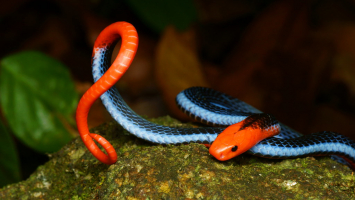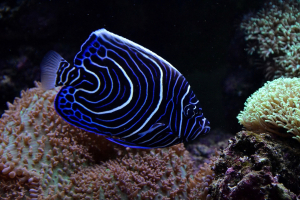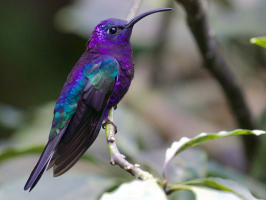Top 10 World's Most Beautiful Iguanas
There are more than 40 distinct species of lizards in the Iguanidae family, which are all of different sizes, forms, and colors. Have you ever wondered which ... read more...iguanas on the planet are the most beautiful? Below is a list of the most beautiful iguanas in the world, let's find out!
-
The Lesser Antillean Iguana (Iguana delicatissima) is a large arboreal lizard endemic to the Lesser Antilles. It is one of three kinds of iguanas, and because of habitat destruction, feral predator introductions, poaching, and hybridization with its invasive sister species, the green iguana, it is suffering from a catastrophic decrease. Successful captive breeding of this species has been limited to only two instances, as most captive-laid eggs tend to be infertile.
The Lesser Antilles iguana lacks the unique stripe pattern found along the green iguana's tail and has a blockier, shorter face than the latter. The larger, spherical scale that the green iguana has below each ear hole but the Lesser Antillean iguana does not possess is the characteristic that most readily distinguishes these two species. Varying island populations of the Lesser Antillean iguana have different color patterns, but the base hue is often gray with green splotches on the underbelly. On their heads, they have broad scales that are ivory-colored and pale. Males have pink jowls, and the scales around their eyes are blue. Additionally, males have femoral pores on the inside of each thigh, which secrete pheromones during the breeding season. Males are larger than females and are 40 cm long, with an 80 cm tail when full-grown. Females are two-thirds this size.

Wikipedia 
Kidadl -
The Fiji Crested Iguana or Fijian crested iguana (Brachylophus vitiensis) is a critically endangered species of iguana native to some of the northwestern islands of the Fijian archipelago, where it is found in dry forest on Yaduataba (west of Vanua Levu), Yadua, Macuata, Yaquaga, Devuilau (Goat Island), Malolo, Monu, and Monuriki. Fiji crested iguanas are predominantly herbivorous feeding on the leaves, fruits, shoots, and flowers from trees and shrubs.
The Fiji crested iguana is a large, stocky lizard that differs from the Fiji banded iguana by having three distinct, cream to white colored bands on males as opposed to the latter species' larger bluish bands. These black chevrons of scales are frequently present next to these white strips. The bigger size of Brachylophus vitiensis, which may reach a maximum length of 75 centimeters and a maximum weight of 300 grams, makes it stand out. It is further differentiated by a higher, spiky "crest" on its back, which extends from the base of its tail to the nape of the neck and has spines as long as 1.5 centimeters in length.

Wikipedia 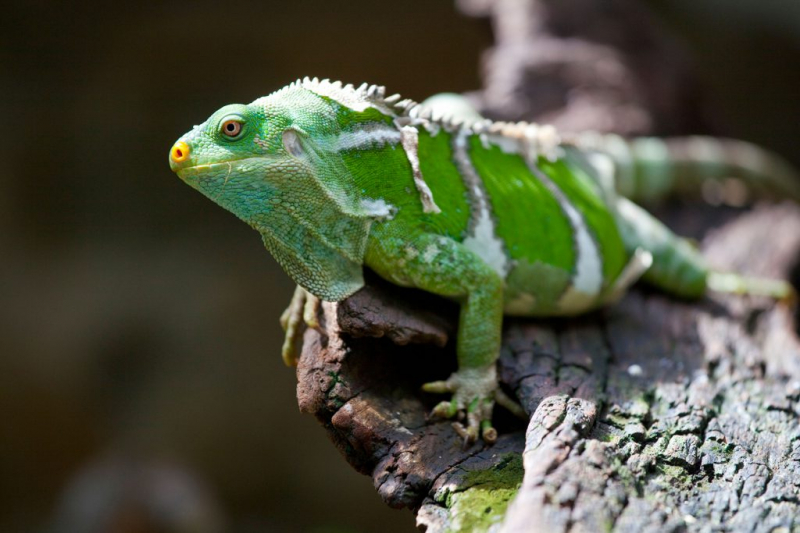
Endangered Wildlife -
Ctenosaura similis, commonly known as the black iguana or Black Spiny-Tailed Iguana, is a lizard native to Mexico, Central America, and some Colombian islands in the Caribbean Sea and the Pacific Ocean. It has been introduced to the United States in the state of Florida. It is the largest species in the genus Ctenosaura. They are typically found in areas such as grasslands and forests.
The name "black spiny-tailed iguana" refers to the species' unique black, keeled scales on its long tail. Males can reach lengths of up to 1.3 meters, while females can only reach lengths of 0.8 to 1 meters. They have a long spine crest that runs down the middle of their back. Despite the fact that color varies greatly among members of the same population, adults often have a yellowish gray or tan background color with 4–12 distinct dark dorsal bands that almost reach the ventral scales. During the breeding season, males also acquire an orange hue around their heads and throat, with blue and peach accents on their jowls.

Wikipedia 
Wikipedia -
The Galápagos Land Iguana (Conolophus subcristatus) is a very large species of lizard in the family Iguanidae. It is one of three species of the genus Conolophus. It is endemic to the Galápagos Islands, in the dry lowlands of the islands of Fernandina, Isabela, Santa Cruz, North Seymour, Baltra, and South Plaza. Like other reptiles from the Galapagos islands, these iguanas are unavailable to private keepers. They’re heavily protected, and importation isn’t currently possible.
Typically, the top of the body is brownish-red and the bottom is burned orange. When fully mature, these girthy lizards are about three feet long. They don't climb very frequently. Instead, they choose to lie on a volcanic rock or take sunbathe to control their body temperature. The food of Galapagos land iguanas consists primarily of plant material. However, they will occasionally consume centipedes as a high-protein snack. Some people even consume the rotting flesh of dead animals.

Galapagos Conservation Trust 
Voyagers Travel -
The Green Iguana (Iguana iguana), also known as the American iguana or the common green iguana, is a large, arboreal, mostly herbivorous species of lizard of the genus Iguana. The green iguana has a wide geographic range; it is native to southern Brazil, Paraguay, and as far north as Mexico. It was introduced to Puerto Rico from South America and is widely distributed there; it is known locally as gallina de palo (bamboo chicken) and is regarded as an invasive species there. In the United States, feral populations also exist in South Florida (including the Florida Keys), Hawaii, the U.S. Virgin Islands, and other places. Green iguanas have also successfully colonized the island of Anguilla, arriving on the island in 1995 after rafting across the Caribbean from Guadeloupe, where they were introduced.
It is a herbivore, and as a result of its food, it has made substantial adaptations to its locomotion and osmoregulation. Although some specimens have grown to more than 2 m in length and have bodyweights beyond 20 lb, the species typically reach a length from head to tail of 1.5 m. Due to its placid nature and vibrant colors, it is frequently kept in captivity as a pet, but taking good care of one can be very hard. A hobbyist may find it difficult to accommodate the space needs and the demand for specialized lighting and heat.

Pinterest 
Depositphotos -
Brachylophus bulabula (central Fijian Banded Iguana) is a species of iguanid lizard endemic to some of the larger central and northwestern islands of Fiji (Ovalau, Kadavu, and Viti Levu), where it occurs in Fijian wet forest. In 2008, a group from the Australian National University led by a scientist described it. It is one of the few iguana species found outside of the new world and one of the Iguanidae family's geographically remotest members. Originally reported from Gau Island as well, B. gau was identified as a distinct species in 2017.
They can grow up to 2 feet long and have an average lifespan of 10-15 years. However, there have been some captive Fiji banded iguanas that have lived as long as 25 years. Tropical wet islands between 650 and 1700 feet above sea level are the typical habitat of the Fijian-banded iguana. They also like to bask in temperatures ranging from 75 degrees- 95 degrees Fahrenheit. The areas that are most suitable for Fiji-banded iguanas are Viti Levu, Vanua Levu, Ovalau, Viwa, and Kadavu. Males are typically green with blue stripes and the females are green with white stripes.

Smithsonian's National Zoo 
Smithsonian's National Zoo -
The Yucatán Spiny-Tailed Iguana (Cachryx defensor) is a species of lizard in the family Iguanidae. It is endemic to northern Yucatán, Mexico. The Yucatan Dwarf Club-tailed Iguana is mostly an arboreal species of iguana, though they have been seen on the ground basking, hunting, and avoiding predators on rocky outcroppings. Their eating habits are a little odd because they favor leaves over the typical iguana diet of flowers, fruit, and saplings.
Though most of its body is brown and grey, it has bright orange patches across its midsection. This unique coloration along with its wide, spiked tail makes the Yucatan spiny-tailed iguana a stunning sight to behold. This species' breeding season starts in the spring, and to entice females, males engage in overt visual and physical displays. Although the female is picky about choosing the ideal location to lay her eggs, generally in a tree hollow or in a rocky fissure, she does not offer parental care for the young and may even leave the region while they are incubating. Between April and June, the eggs hatch, bringing about the start of the young's solitary existence.

Wikipedia 
Natusfera - iNaturalist -
The blue iguana (Cyclura lewisi), also known as the Grand Cayman ground iguana, Grand Cayman Blue Iguana, or Cayman Island rock iguana, is an endangered species of lizard that is endemic to the island of Grand Cayman. It was previously thought to be a subspecies of the Cuban iguana, Cyclura nubila, but Frederic J. Burton reclassified it as a separate species in a 2004 article because, in his opinion, the genetic variations discovered between the various C. nubila populations four years earlier justified this interpretation. One of the lizard species that can live the longest is the blue iguana (possibly up to 69 years).
Because female blue iguanas must dig holes in the sand to lay eggs in the months of June and July, their preferred habitat is rocky, sunny, open regions in dry woods or close to the sea. September sees the possible laying of a second clutch. Plants, fruits, and flowers are all parts of the herbivorous diet of the blue iguana. Its brown to gray tint has a bluish cast that is particularly noticeable in the breeding season and on males. It is huge and heavy-bodied, with a dorsal crest of short spines extending from the neck's base to the tail's tip.

Wild View - Wildlife Conservation Society 
iStock -
Conolophus marthae, the Galápagos Pink Land Iguana, is a species of lizard of the family Iguanidae. This critically endangered iguana is native only to the Wolf Volcano in northern Isabela Island of the Galápagos Islands (Ecuador). The pink iguana was discovered and first described by National Park rangers in 1986, but it wasn't until 2009 that the pink iguana was formally recognized as a distinct species from the other land iguanas in Galapagos since it had previously been mistaken for an anomaly. One of the oldest occurrences of divergence known in the Galapagos was the divergence, which according to additional genomic studies occurred 5.7 million years ago.
Although they resemble Galapagos land iguanas in appearance, with a short head and strong hind legs, and sharp claws on their toes, they are predominantly herbivores that eat the leaves and fruit of prickly pear cactus. Their body is pink with dark vertical stripes running along it, and that is the only distinguishing feature. Due to their skin's lack of pigment, their pink coloring makes it possible to glimpse the blood underneath.

Phys.org 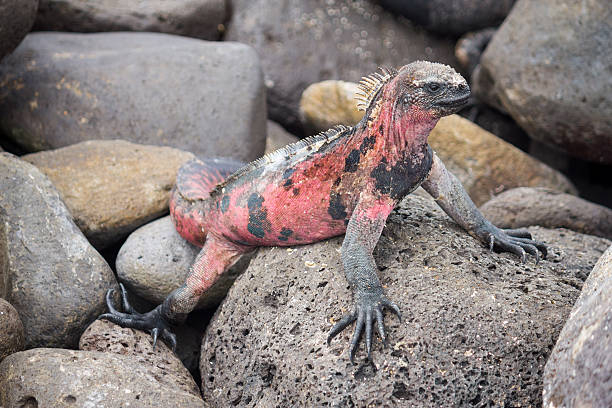
iStock -
The Desert Iguana (Dipsosaurus dorsalis) is an iguana species found in the Sonoran and Mojave Deserts of the Southwestern United States and northwestern Mexico, as well as on several Gulf of California islands. Their preferred environment, primarily dry, sandy desert scrubland below 1,000 meters, is mostly contained within the creosote bush's range (3,300 ft). They are widely dispersed over the Sonoran and Mojave deserts. Additionally, they are present in rocky streambeds up to 1,000 meters. These lizards live in areas of tropical deciduous woodland and arid subtropical scrub in the southern part of their range.
The desert iguana is a medium-sized lizard that can reach a maximum length of 61 cm when the tail is included. Its usual total length is 41 cm. They have a light brown reticulated pattern on their backs and flanks and are a light gray-tan to cream tint. A row of slightly expanded, keeled dorsal scales can be seen running down the middle of the back; these scales get larger as they go further down the back. Near the back legs, the reticulated pattern is replaced with brown spots, which later transform into stripes down the tail. From snout to vent, the tail is typically around 112 times longer than the body. The stomach is pallid. Both sexes' flanks get pinkish during the breeding season.

Wikipedia 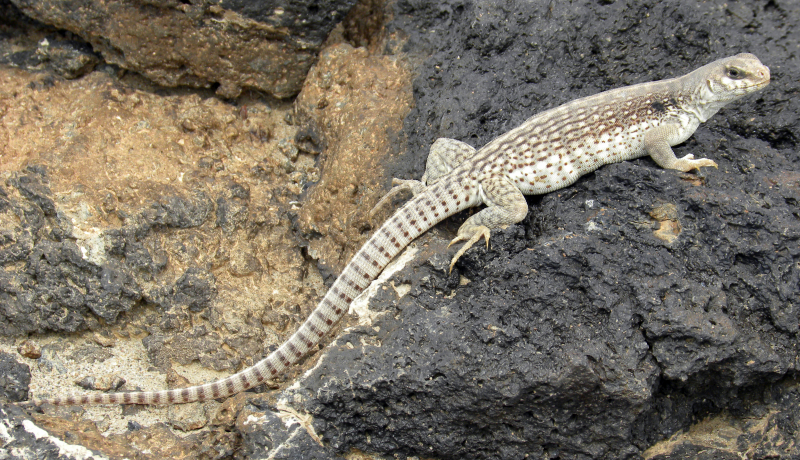
Wikipedia






















